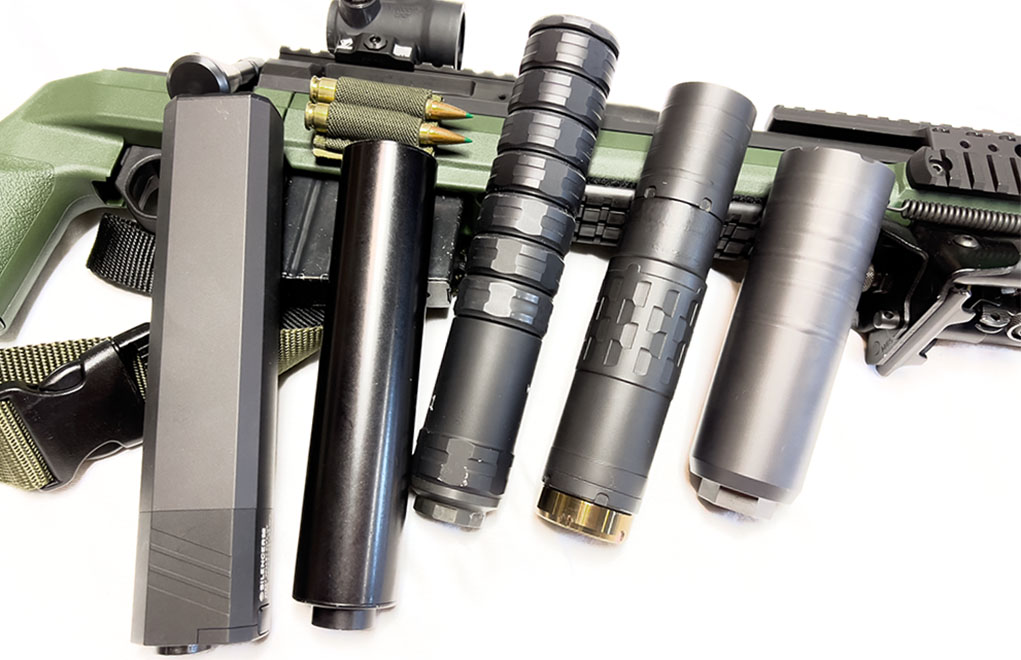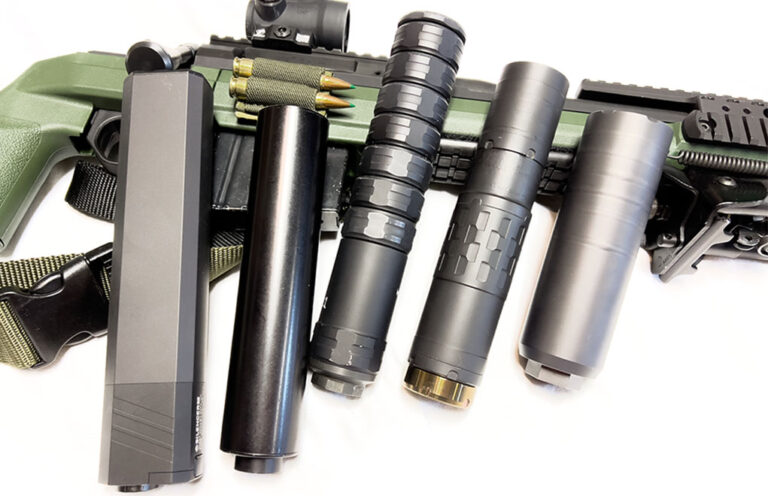
The author covers a few facts you should know before starting your suppressor-buying journey.
In the past few years, I’ve become something of a suppressor collector. I have a pretty decent number of tax stamps, and I really enjoy using suppressors on all my modern guns. One of the things I did when looking at models to buy was to make sure that I was getting the correct end-use down for each one.
There are undeniable differences when it comes to various suppressor models, materials, means of attachment and assembly. While the basic concept is reducing the noise signature of a given firearm, there’s rarely a one-size-fits-all option for consumers … unless they want to shoot just one caliber.
Let’s look at what might be best for you.
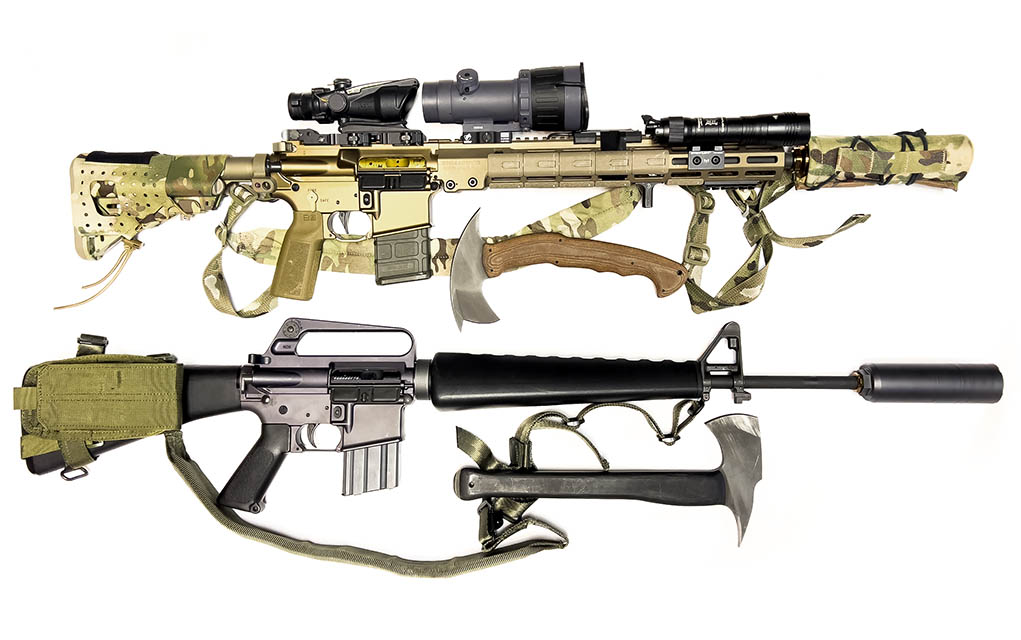
All For One
It goes without saying that there are more types of guns being made adaptable to suppressors these days than any time in the past. Lots of guns from the factory are now coming threaded at the muzzle as a standard feature—it’s not only AR-type rifles, but it’s also bolt actions, pistols and all manner of rimfire designs.
Sadly, there’s no real way to have your cake and eat it, too—if you’re trying to suppress a whole host of firearms with a single suppressor. Many designs come close, but there are still issues involved, and they can be complex to understand.
One of the main problems is the use of rimfire cartridges in suppressors. Many people are disappointed to find that, aside from a few outliers, it’s not recommended to use a centerfire suppressor on rimfire rifles. This has to do with cleanliness and ease of disassembly. Rimfire ammunition is extremely dirty, and the bullets are lubricated.
You may not realize it, but common .22 LR ammunition isn’t built from a 20th-century design, but rather the 19th century. The bullet design and the way the cartridge is assembled is quite ancient by our modern standards.
When shooting rimfire ammo, the bullet lube vaporizes, leaving a waxy layer on everything. This waxiness is incredibly good at trapping unburned propellant, carbon and lead residue. In short, if you want to gunk up a centerfire suppressor, you don’t have to try very hard. This can lead to dangerous pressure situations inside the suppressor when firing full-power centerfire ammunition.
You’ll also find that not every pistol suppressor is capable of being used on a rifle. There are, of course, many models that are adaptable to both, but, in general, it’s easier to try to adapt a rifle suppressor for a pistol than it is to do the opposite. There are many excellent models dedicated to use on pistols; you’ll typically find that these are lightweight, often constructed of aluminum, and are also meant to work wet or dry.
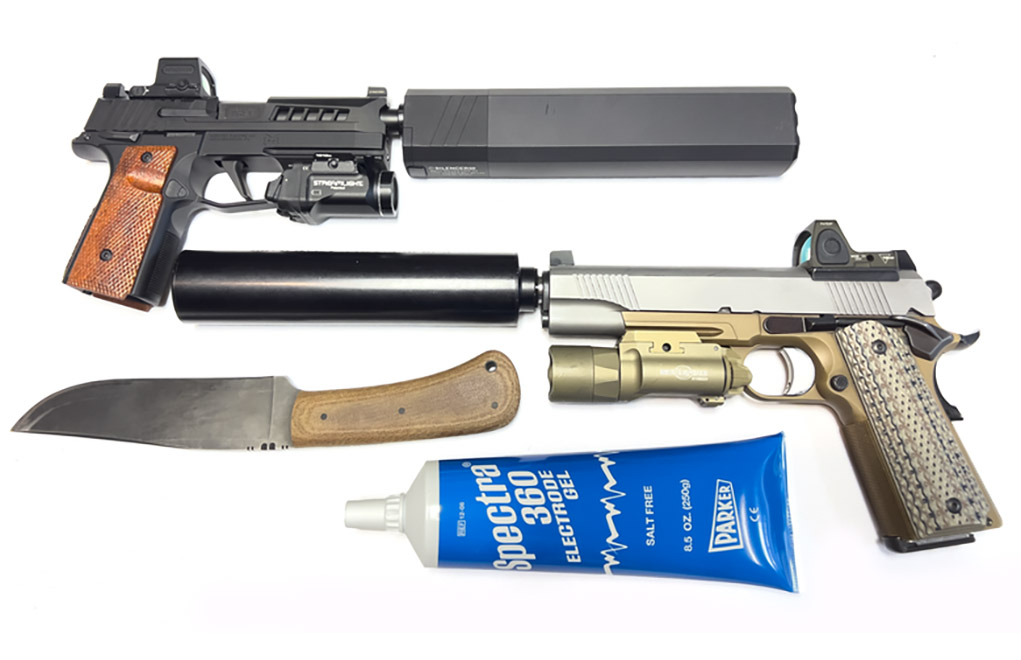
The most effective pistol suppressors are going to be versions that allow you to put gel or a little water inside. Shooting handguns wet significantly reduces the noise signature, and with subsonic ammunition it can get down to paintball gun levels of quiet.
However, you should never fire a rifle suppressor wet. Meaning, if you adapt a rifle suppressor to work with a handgun, you should never put gel in them. This can lead to a dangerous situation when switching to centerfire rifle ammunition. The closed-design Bowers ASP 45 in this article is meant to be used wet only on full-size .45 ACP pistols. The SilencerCo Osprey 2.0 is able to be used wet or dry.
You’ll find that specialization runs deep in the suppressor market. If you want to suppress a range of firearms, you’re likely going to need several types of suppressors to check that box. The unfortunate truth of this means that you’ll be paying a hefty sum in taxes to Uncle Sam for the privilege of shooting in comfort. This cost adds up quickly, and if you were already paying a good amount for the suppressor, it always feels like salt in the wound having to pay $200 and wait for months.
To cover all your bases with the fewest number of suppressors possible, you’ll likely need a dedicated rimfire model, a wet/dry pistol suppressor and a modular rifle-rated suppressor.
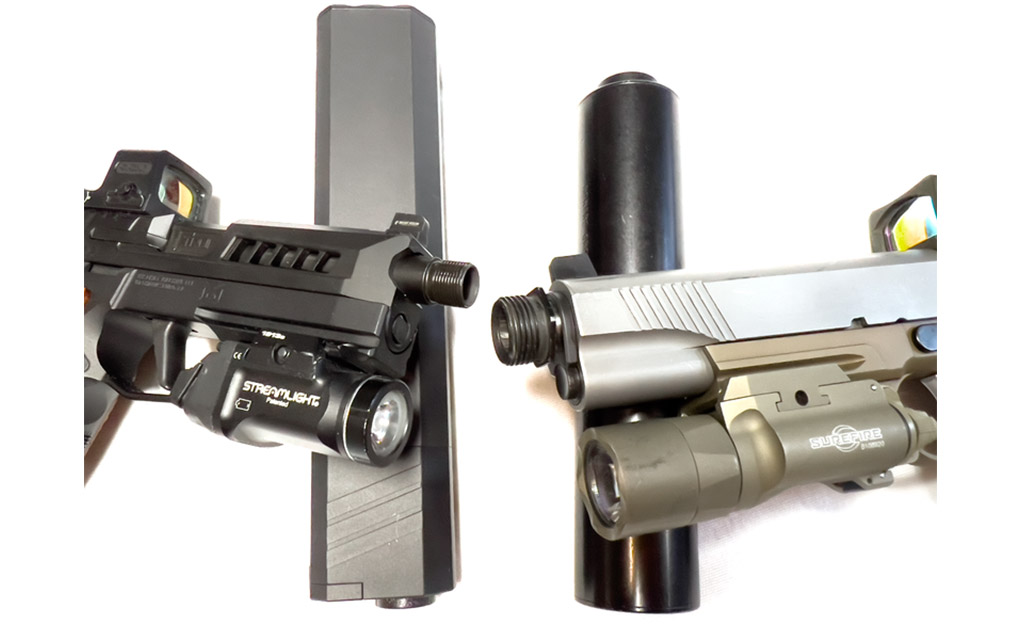
Mounting can be a pain as well—and costly, too. Virtually all rimfire and pistol suppressors are direct thread, meaning they’ll attach directly to the end of the barrel. On rifles, you can usually get away with a type of universal mount, such as various models of the Q-style Cherry Bomb mount or the SilencerCo ASR System.
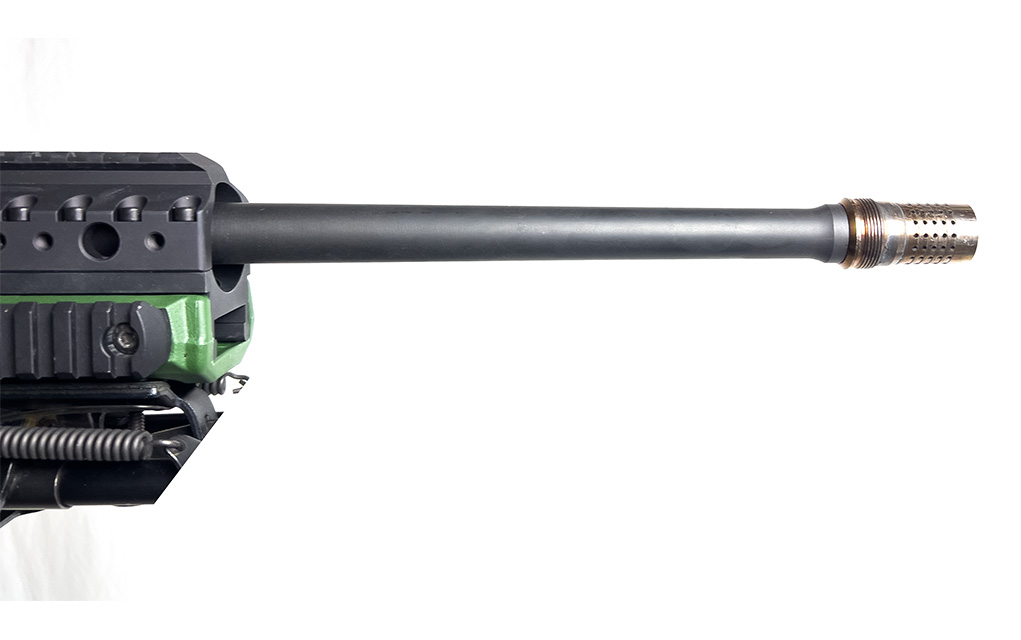
There are pros and cons to each one, but luckily, there are companies like Rearden Manufacturing that make a whole host of adapter pieces to allow you to thoroughly uniform your mounting systems. Most of my suppressors use Rearden adapters or Q factory Cherry Bombs. A good example of a do-all setup is the SilencerCo Hybrid 46M, a modular suppressor that can be adapted to virtually any centerfire rifle up to .458 Winchester Magnum. If you have five rifles, you’d need five mounts, and at around $100 a pop, you’ll be looking at the cost of a used pistol just to have interchangeability on your rifles with the suppressor—it’s something to be aware of if you want to add the quick mounting capability to your rifles.
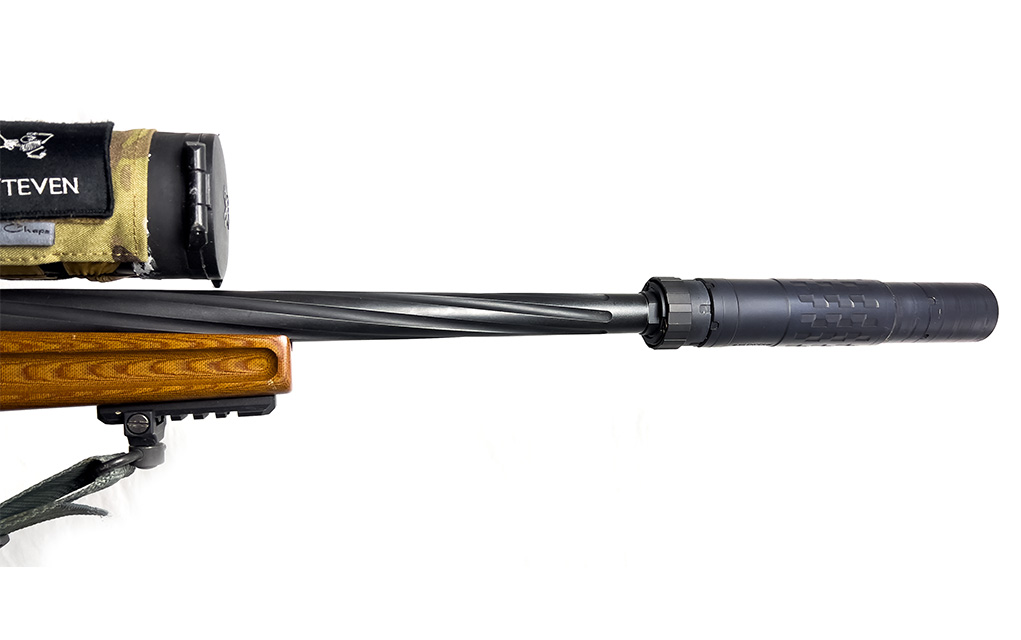
One-Trick Pony
In contrast, some people have a very specific end-use, and a very specific caliber requirement for what they want to suppress. It’s this type of shooter who benefits most from a sealed, fixed-caliber suppressor, and where a great deal of weight savings over modular designs can be found.
If you’re a hunter using .30-caliber and 6.5mm centerfire rifles, you can easily use a single suppressor that can directly thread to your barrel, seeing as how both bore diameters commonly use a 5/8-24 thread pattern. If weight savings and efficient length is paramount, this is arguably your best option. You don’t have to worry about QD mounts—just a thread protector for your unused rifles in the safe.
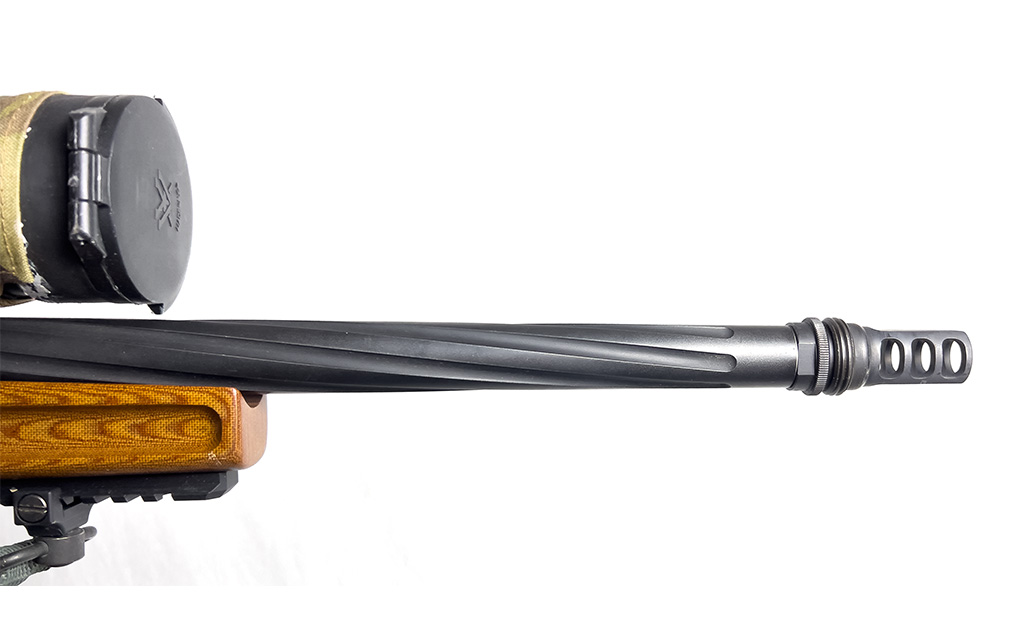
You can add significant weight with mounts and hardware to where things get cumbersome, so keep that in mind as you shop. Hunting rifles should ideally be light, and every added ounce can change the balance and handling of your rifle, especially on thin-barreled walking or pack rifles with longer barrels.
You’ll see that these sealed designs, like the Q Jumbo Shrimp featured in photos of this article, are very small and add only a little length to the rifle. I routinely shoot this suppressor on my 6.5mm bolt guns and 5.56mm AR carbines. It’s not the quietest suppressor out there, but it is light.

The shorter you go the louder a suppressor will be. It’s a trade-off. If you’re wanting maximum noise reduction, however, that comes with weight and length. If you’re wanting to simply take the edge off the blast and control recoil, this type of suppressor will be your best friend. Not everyone wants a huge can—just having something that allows you to focus on the shot is enough. My Jumbo Shrimp still hurts my ears on a 16-inch AR in 5.56 NATO, but it’s a pleasure on my Brownells M16A1 retro 20-inch. On a 24-inch 6.5 Creedmoor, my ears barely ring at the crack of the shot. Wearing hearing protection is still the best way to go, but you get the idea.

A Can for All Conditions
The downside of using a sealed can, long or short, is the limited options you have. If you’ve got a shorty carbine—say a 16-inch .308 Win.—and you want to suppress it with your .30-caliber suppressor, well, you’re stuck at whatever length and weight you have. The market for modular suppressors has grown and the two featured here, the SilencerCo Hybrid 46M and Omega 36M, are the pinnacle of adaptability. But they also come with a weight penalty. These are my heaviest suppressors, but they can be made to work with any rifles and pistols I currently have … though not rimfire.
The adapter parts on these suppressors allow me to change from direct thread to QD mounts. Rearden makes a Q-style adapter so I can use them with the Cherry Bomb. I can change length and endcap bore size, and I can change the rifle mount to a pistol adapter piston. These are utterly impressive in how many different cartridges can be used with them. If you’re maxing out at a 9mm bore, get the 36M. You can run .350 Legend for deer hunting, then swap it onto a .338 Lapua or 8.6 Blackout. Take the rear mount off and install a pistol piston, then use it on your Sig or Glock. Don’t like all the length and weight shooting pistols? Shorten it by unscrewing the forward baffle stack and re-install the endcap. It’s that simple.
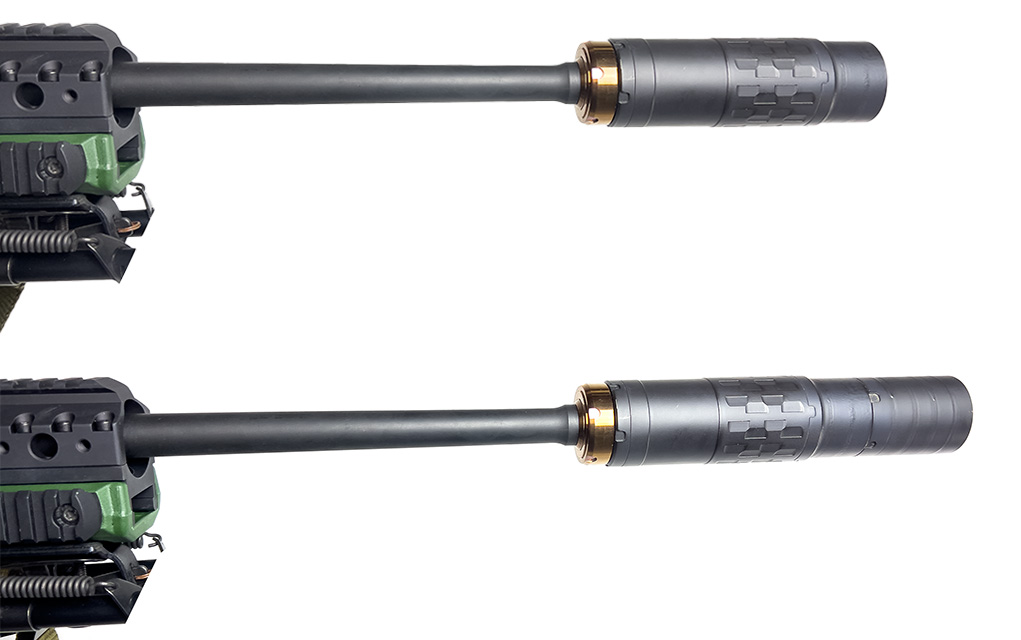
Modular suppressors are incredible and offer a tremendous amount of utility. I’ve dropped over a dozen big-bodied whitetails in the past 2 years with the 46M on my .450 Bushmaster, and it has changed deer hunting for me. However, that rifle is already heavy, and putting this large suppressor on certainly makes it harder to handle. My total carry weight is just under 15 pounds, making it quite the pain in the you-know-where to lug around. I plan on dropping this weight down with some new carbon-fiber parts soon.
Weight on already heavy guns is my main complaint, but it’s more of a problem on lighter guns, where you can immediately feel the difference in balance.
Stackin’ Baffles
Some suppressors, like the JK Armament 155 series also pictured in this article, offer even more capability by nature of their design. This added utility largely has to do with maintainability, and you can, in fact, shoot rimfire and cast lead bullets through these safely, provided you clean them before switching to standard centerfire. The design is modular in the same spirit as other modular cans, but you can disassemble these down to the individual baffle.
This means you can shoot Earth’s dirtiest ammo and simply take them all the way apart to scrub the baffles. Not only that, but you can also “tune” them to the length that best suits you. If you want to save some weight or reduce length, you can reduce the stack; if you want maximum suppression, you can go longer.
These suppressors are ideal if you’re a fan of lever guns or running cast handloads for plinking or fun. The utility here is just so nice, and you can really get your money’s worth out of this product line. Now, you’ll need to decide what you want your initial internal baffle stack to be—for instance, .45-caliber, 9mm, .30-caliber, etc.—but you can change the endcap. I use a JK 9mm-bore can with a .22-caliber endcap on some of my 5.56mm AR rifles … but I’ve also used it on .350 Legend and .308 Win. I use a .22 bore JK suppressor in rifle size for my .22LR rimfire rifles, but I’ve also used it on 5.56mm carbines after cleaning. There’s just so much utility here that it’s hard to go wrong.
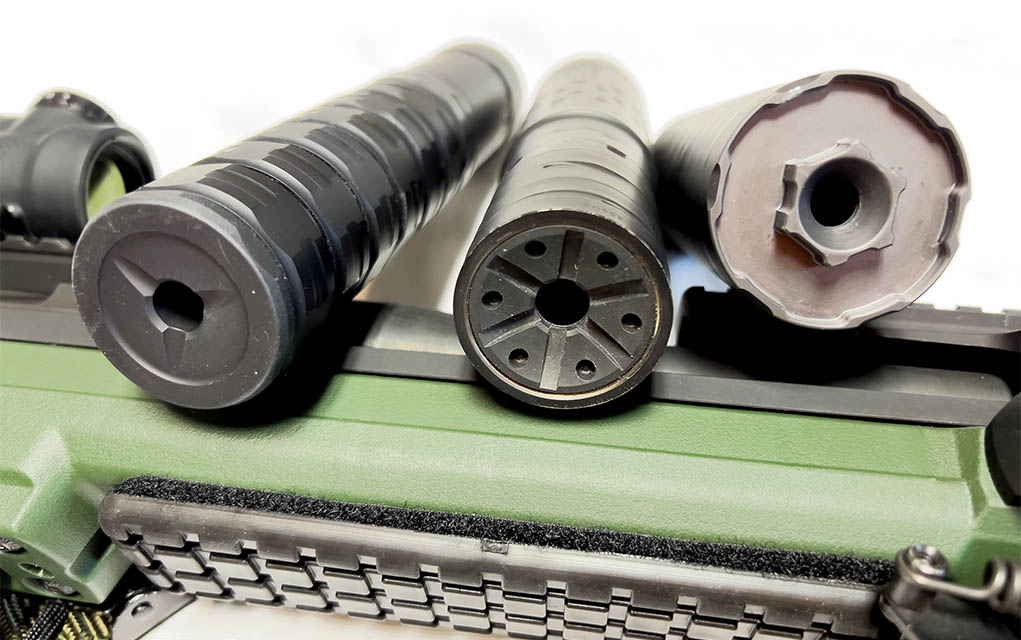
Suppressor Thoughts
As a dedicated suppressor shooter, I try to be objective about my end use. Guns today get heavy very fast as accessories mount, and it’s possible to overload a gun with weight and length. I like shorter barrels with suppressors, as I like to have maximum suppression on my hunting guns. However, there’s no getting around the fact that many suppressors will add almost a pound to the muzzle in centerfire calibers. It’s hard to have a truly light and maneuverable gun when you’re deliberately adding weight, and this goes double for pistols.
If you have a reasonable expectation and aren’t trying to get your suppressor to do something it wasn’t made for, well, you’ll have a great time. Suppressors are great tools when you understand what you’re getting into. My advice is not to buy one based on online reviews or the scrawling of a gunwriter like myself; instead, make the time to go find a dealer or NFA shop and ask to demo products.
That, or get yourself to an event like CANCON and try out a bunch. In the end, I know you’ll be fine because, like me, you’ll get the bug and end up having to explain to the wife that this new suppressor does something different than the last seven … or was it eight?
Editor’s Note: This article originally appeared in the Suppressor Special 2024 issue of Gun Digest the Magazine.
More On Suppressors:

Next Step: Get your FREE Printable Target Pack
Enhance your shooting precision with our 62 MOA Targets, perfect for rifles and handguns. Crafted in collaboration with Storm Tactical for accuracy and versatility.
Subscribe to the Gun Digest email newsletter and get your downloadable target pack sent straight to your inbox. Stay updated with the latest firearms info in the industry.
